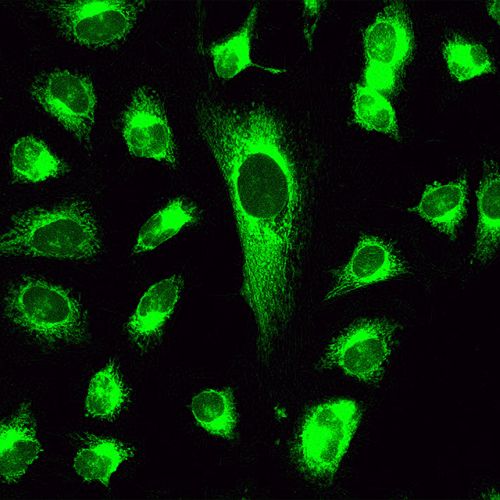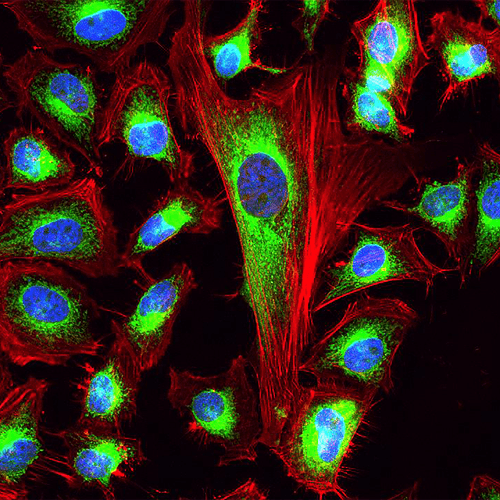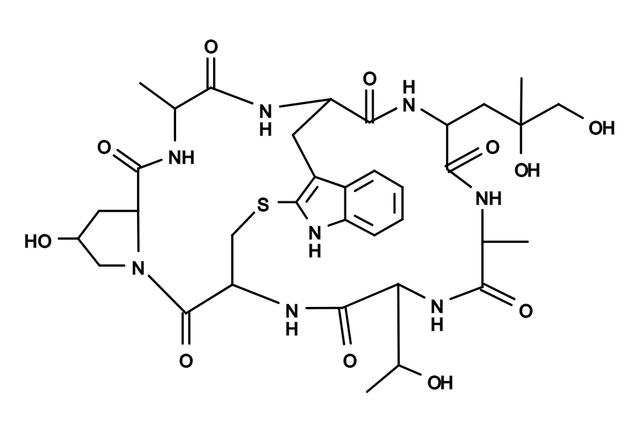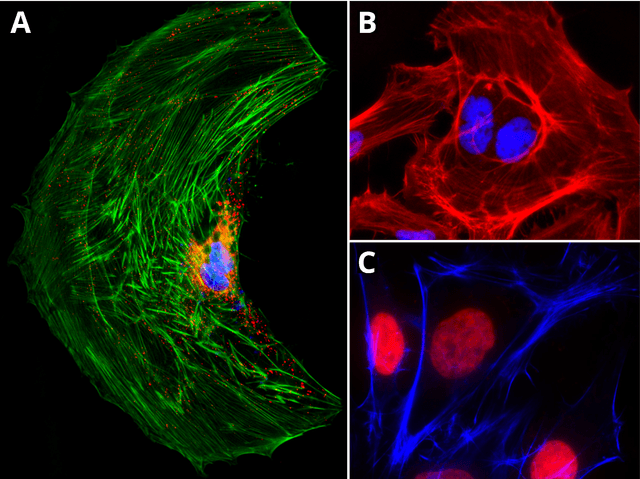Actin
Actin is a highly conserved family of proteins that form microfilaments. Due to its intracellular abundance in eukaryotic cells, well within micromolar concentrations, actin participates in the most protein-protein interactions than any other known protein. Fluorescent derivatives of phalloidin have turned out to be enormously useful in localizing actin filaments in fixed cells and tissues, as well as, for visualizing individual actin filaments in vitro. Fluorescent phalloidin derivatives have been used as an important tool in the study of actin networks at high resolution.
Actin
Actin possesses a unique ability to dynamically polymerize into filamentous actin (F-actin) from its monomeric state. Interactions between F-actin and regulatory proteins such as actin-binding proteins rapidly assemble and disassemble actin filaments organizing them into actin bundles and cytoskeletal networks. These higher-order structures provide the mechanical and structural support essential for a multitude of cellular processes including intracellular transport, cytokinesis, cell motility, polarity and cell shape, gene regulation and signal transduction. Because actin is essential in so many biological processes, tools (actin-specific antibody and phalloidin derived stains) for the visualization of these actin structures are essential in research.
Detecting Filamentous Actin (F-Actin)
F-Actin stains are commonly used to characterize the stucture and functionality of the cytoskeleton. Because the actin cytoskeleton is a very dynamic and labile structure in living cells it typically requires either cold methanol or paraformaldehyde fixation prior to labeling actin. In fixed cells, actin structures can be visualized by actin antibodies, fluorescent phalloidin, or electron microscopy. Antibodies recognize both monomer and polymer (filamentous or F-actin) actin and hence tend to have a high background compared to probes that bind only F-actin. Correctly designed fluorescent phalloidin only binding to the native quaternary structure of F-actin and therefore have a low background.
Fluorescence composite image. Live HeLa cells were stained with mitochondria dye MitoLite™ Green EX488 (Cat No. 22675) and imaged. After fixation in 4% formaldehyde, cells were stained with F-actin probe Phalloidin-iFluor™ 633 Phalloidin (Cat No. 23125) and nuclear counterstain Nuclear Blue™ DCS1 (Cat No. 17548).
Phalloidin
Phalloidin, the main representative of the phallotoxin family, is a bicyclic heptapeptide isolated from the poisonous death cap mushroom, Amanita phalloides. It possesses a high binding affinity for the grooves between F-actin subunits over monomeric G-actin. Compared to actin antibodies, non-specific binding of phalloidin is negligible, thus providing minimal background and high-contrast during cellular imaging. Once bound to F-actin, phalloidin shifts the equilibrium of monomers and filaments toward the filaments position, and inhibits ATP-hydrolysis. The interaction stabilizes actin filaments by preventing subunit dissociation, and it promotes actin polymerization by lowering the critical concentration. As a consequence, these characteristics have made phalloidin derivatives useful stains in visualizing F-actin and cytoskeletal networks.
Properties of Phalloidin Derivatives
Phalloidin derivatives are water soluble and when used at nanomolar concentrations can selectively stain F-actin. Unlike some antibodies against actin, phalloidin's capacity to bind more tightly to actin filaments over monomers decreases non-specific staining and background noise, producing better contrast between stained and unstained areas. In comparison to antibodies, phalloidin derivatives' are small.
Choosing the Right Phalloidin Derivative
Due to its notable staining abilities, an array of phalloidin derivatives has been developed to study and visualize actin filaments and actin-related structures. Summaries of the properties of unlabeled, biotinylated, and fluorescently labeled phalloidin derivatives can be found below.
Unlabeled Phalloidin
Unlabeled phalloidin (Cat No. 5301) has limited uses. Other than serving as promotor of actin polymerization, unlabeled phalloidin is typically used as a control in blocking F-actin staining, as well as, a building block for developing phalloidin conjugates.
Biotinylated Phalloidin
Biotinylated phalloidin provides and indirect method for visualizing and quantitating actin filaments. It requires the use of a fluorescent or enzyme-conjugated avidin or streptavidin for visualization. Whilst indirect detection offers the benefit of signal amplification, the need for additional reagents increases costs and assay time. Additionally, when staining with biotinylated phalloidin a higher concentration of the phalloidin conjugate is required, approximately two-fold more than needed with fluorescent phalloidin. Regardless of the inconveniences, biotinylated phalloidin are favorable for pull-down and immunoprecipitation assays for investigating protein interactions and colocalization with F-actin.
Fluorescent Phalloidin
Fluorescently-labeled phalloidins are designed to investigate F-actin distribution in fixed and permeabilized cells. Compared to actin antibodes, fluorescent phalloidin conjugates are substantially smaller. This small size permits much denser labeling of F-actin which allows for the capture of more detailed images at higher resolutions.
Phalloidin-iFluor™ conjugates
Exploiting the excellent fluorescence properties of our iFluor™ dyes, AAT Bioquest has developed a series of phalloidin conjugates spanning the full color spectrum which selectively bind to F-actins. Used at nanomolar concentration, these iFluor™ phalloidin derivatives are convenient for many actin-related assays. Such assays include labeling, identifying, and quantitating F-actins in formaldehyde-fixed and permeabilized tissue sections, cell-cultures, or cell-free experiments. Compared to traditional fluorescein isothiocynanate (FITC) and rhodamine conjugates, Phalloidin-iFluor™ conjugates offer F-actin stains that are superior in brightness and photostability. Phalloidin-iFluor™ conjugates are equivalent, and in most cases superior, to Alexa Fluor® conjugates in performance.
Phalloidin-iFluor™ 350 to Phalloidin-iFluor™ 596 conjugates come packaged as 1000X stock solution in DMSO and are ready to be used as supplied. Phalloidin-iFluor™ 633 to Phalloidin-iFluor™ 790 conjugates come packaged as a lyophilized powder and must be prepared in 1000X stock solution. Both conjugates are stable for at least six months when stored at proper conditions. If not to be used immediately, store Phalloidin-iFluor™ conjugates at -20 °C, protect from light and avoid freeze-thaw cycles. We encourage the research community to try our Phalloidin-iFluor™ conjugates with their respective protocols for a more intense fluorescence in their F-actin staining. Phalloidin-iFluor™ 700, iFluor™-750 and iFluor™-790 conjugates are among the few near-infrared stains available with sufficient spectral separation from commonly used red fluorophores.
Table 1. Overview of fluorescent phalloidin conjugates
| Specification ▲ ▼ | Value ▲ ▼ |
| Application | Fluorescent imaging of filamentous actin (F-actin) |
| Sample Type | Fixed & permeabilized cells, cell cultures, cell-free experiments, formaldehyde-fixed & permeabilized tissue sections |
| Cellular Localization | F-actin of the cytoskeleton and contractile apparatus of muscle cells (does not bind to monomeric G-actin) |
| Live/Fixed Cells | Fixed cells only |
| Permeability | Cell impermeant |
| Multiplexing | Yes |
| Platform | Fluorescence microscope and imaging platforms |
Table 2. iFluor® Phalloidin Selection Guide For Phalloidin-iFluor® Conjugates
| Conjugate ▲ ▼ | Mol. Wt. ▲ ▼ | Ex/ Em (nm) ▲ ▼ | Filter Set ▲ ▼ | Extinction Coefficient¹ ▲ ▼ | Quantum Yield ▲ ▼ | Unit Size ▲ ▼ |
| Phalloidin-iFluor® 350 | ∼1300 | 344/448 | DAPI | 20,000 | 0.95 | 300 Tests |
| Phalloidin-iFluor® 405 | ∼1400 | 402/425 | DAPI | 37,000 | 0.91 | 300 Tests |
| Phalloidin-iFluor® 488 | ∼1900 | 491/516 | FITC | 75,000 | 0.9 | 300 Tests |
| Phalloidin-iFluor® 514 | ∼1800 | 527/554 | TRITC | 80,000 | 0.83 | 300 Tests |
| Phalloidin-iFluor® 532 | ∼1800 | 543/563 | TRITC | 90,000 | 0.68 | 300 Tests |
| Phalloidin-iFluor® 555 | ∼1300 | 556/569 | TRITC | 100,000 | 0.64 | 300 Tests |
| Phalloidin-iFluor® 594 | ∼1600 | 587/603 | Texas Red | 180,000 | 0.53 | 300 Tests |
| Phalloidin-iFluor® 633 | 1703.99 | 638/652 | Texas Red | 250,000 | 0.29 | 300 Tests |
| Phalloidin-iFluor® 647 | 1632.87 | 654/669 | Cy5 | 250,000 | 0.25 | 300 Tests |
| Phalloidin-iFluor® 680 | ∼2000 | 683/700 | Cy5.5 | 220,000 | 0.23 | 300 Tests |
- ε: molar extinction coefficient at their maximum absorption wavelength (Units = cm-1M-1).
- Φ: fluorescence quantum yield in aqueous buffer (pH 7.2).
Actin Staining Protocol
The following is an sample protocol for staining f-actin in cultured cells using AAT Bioquest Phalloidin-iFluor™ 488 Conjugate.
Storage & Handling Conditions
It is important to note that phalloidin is toxic, although the contents present in each vial are potentially lethal to a mosquito (LD50 of phalloidin = 2 mg/kg), it should always be handled with care.
Phalloidin-iFluor™ conjugates are stable for at least six months when stored at proper conditions. If not to be used immediately, store Phalloidin-iFluor™ conjugates at -20 °C, protect from light and avoid freeze-thaw cycles.
Materials
- Phalloidin-iFluor™ 488 Conjugate (Cat No. 23115)
- PBS (for buffer recipe click here)
- 3.0 - 4.0% Methanol-free formaldehyde
- BSA
- Cell culture
- Optional: 0.1% Triton X-100
- Optional: Ethanolamine
- Optional: FluoroQuest™ Mounting Medium with DAPI (Cat No. 20004)
Actin Staining Protocol
- Warm the vial of Phalloidin-iFluor™ 488 to room temperature and centrifuge briefly before opening.
- Prepare a 1000X Phalloidin-iFluor™ 488 DMSO stock solution by adding 30 μL of DMSO into the vial of Phalloidin-iFluor™ 488.
- Prepare a 1X Phalloidin-iFluor™ 488 working solution by adding 1 μL of 1000X Phalloidin-iFluor™ 488 conjugate DMSO solution to 1 mL of PBS with 1% BSA. Mix well by pipetting solution up and down. This makes enough staining solution for 10 wells at 100 μL/well. Aliquot any unused 1000X Phalloidin-iFluor™ 488 DMSO stock solution and store under proper conditions.
- Note: Staining may vary between different cell types. For optimal performance, the concentration of phalloidin conjugate working solution should be prepared accordingly.
- Fix cells in 3.0 - 4.0% methanol-free formaldehyde in PBS at room temperature for 10 to 30 minutes. Avoid any methanol containing fixatives since methanol can disrupt actin during the fixation process.
- Aspirate fixation solution carefully.
- Rinse fixed cells 2 to 3 times in PBS.
- Optional: Quench excess formaldehyde with 10 mM ethanolamine in PBS for 5 minutes.
- Optional: Increase permeability by adding 0.1% Triton X-100 in PBS into fixed cells for 3 to 5 minutes. Rinse cells 2 to 3 times in PBS.
- In a 96-well plate, add 100 μL/well of Phalloidin-iFluor™ 488 conjugate working solution to cells. Stain cells at room temperature for 20 to 90 minutes.
- Rinse cells gently 2 to 3 times with PBS to remove excess phalloidin conjugate.
- Optional: Add a small drop of FluoroQuest Mounting Medium with DAPI and incubate for 2 hours. This inhibits photobleaching and counterstain nucleus with DAPI.
- Observe cells by using a fluorescence microscope equipped with the appropriate filter set. Phalloidin-iFluor™ 488 requires a FITC filter set for visualization.
Product Ordering Information
Table 3. Ordering Info for Actin Products
| Cat# ▲ ▼ | Product Name ▲ ▼ | Unit Size ▲ ▼ |
| 5301 | Phalloidin *CAS#: 17466-45-4* | 1 mg |
| 5302 | Phalloidin Amine | 100 ug |
| 5303 | Phalloidin-PEG4-DBCO | 100 ug |
| 23100 | Phalloidin-AMCA Conjugate | 300 Tests |
| 23101 | Phalloidin-Fluorescein Conjugate | 300 Tests |
| 23102 | Phalloidin-Tetramethylrhodamine Conjugate | 300 Tests |
| 23103 | Phalloidin-California Red Conjugate | 300 Tests |
| 23110 | Phalloidin-iFluor® 350 Conjugate | 300 Tests |
| 23111 | Phalloidin-iFluor® 405 Conjugate | 300 Tests |
| 23115 | Phalloidin-iFluor® 488 Conjugate | 300 Tests |





